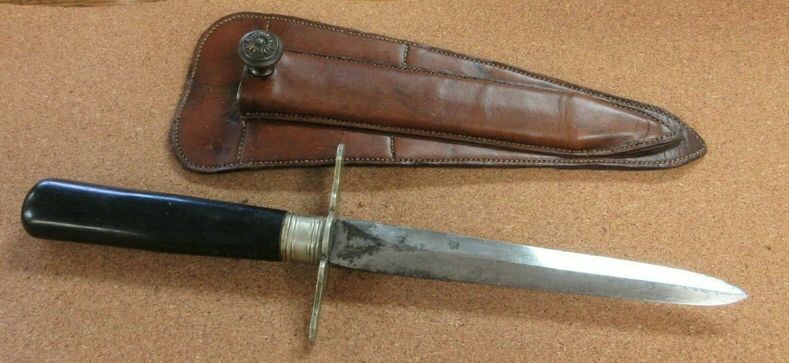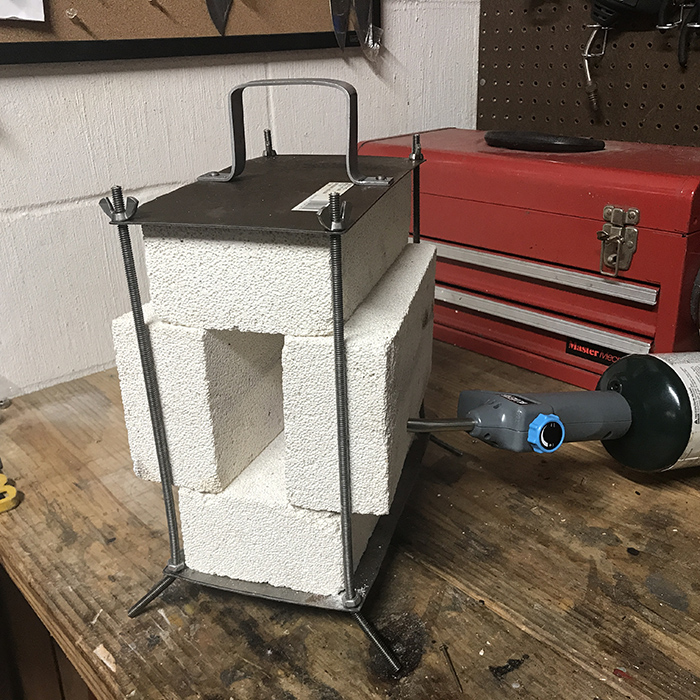| Author |
Message |
Sean Flynt

|
|
   |
 |
Ian Hutchison

Location: Louisiana / Nordrhein-Westholland Joined: 27 Nov 2007
Posts: 626
|
 Posted: Mon 03 Jan, 2022 3:13 pm Post subject: Posted: Mon 03 Jan, 2022 3:13 pm Post subject: |
 |
|
Looks great, really like the sheath too.
'We are told that the pen is mightier than the sword, but I know which of these weapons I would choose.' - Adrian Carton de Wiart
|
|
  |
 |
Sean Flynt

|
|
   |
 |
|
Michael Beeching
|
 Posted: Wed 05 Jan, 2022 11:28 pm Post subject: Posted: Wed 05 Jan, 2022 11:28 pm Post subject: |
 |
|
Sean,
I envy your skill, Sir! WWII kind of strikes me as the last time before an edged weapon "dark age" and more recent years, when that trend seems to be reversing. However, after looking at some of those "theater knives," I wonder if my sentiments are actually reasonable... :P I think your interpretation of a weapon like this is really impressive. I will agree with you that "commando daggers" like this are indeed not extremely practical, unless of course you intend to fight with them (at which point they become entirely practical)! You made a really swell knife from the looks of things, and although it was made with a Windlass blade, it looks a lot more convincing than some of their own reproduction personal knives I've seen.
...If you don't mind me probing you for some insight, I've got a somewhat comparable project going on over on my end. I'm currently cutlering on a Windlass "Arkansas Toothpick" blade; mine came with a "pinched" section between the midsection and the tip, and I've been needing to even that out so as not to end up with a blade section where all the force is concentrated if the blade bends! Did your blade have any such inconveniences you needed to overcome? I did find the hardness of the blade was respectable if my hardness tester files are to be believed: probably about 54 Rockwell C.
|
|
  |
 |
Sean Flynt

|
 Posted: Fri 07 Jan, 2022 8:01 am Post subject: Posted: Fri 07 Jan, 2022 8:01 am Post subject: |
 |
|
Thanks! Iíve used that toothpick for several projects and really like it. Iíve never had one with profile defects, so you must have just (bad) lucked into one. my main complaint about WS heat treatment is the hardness of the tang. that seems to be typical, and it can make reshaping and peening a headache. i usually anneal the tang early in a project to avoid a hassle later. iíve just finished a bench-top forge that will make that much easier. whatís your project?
-Sean
Author of the Little Hammer novel
https://www.amazon.com/Little-Hammer-Sean-Flynt/dp/B08XN7HZ82/ref=sr_1_1?dchild=1&keywords=little+hammer+book&qid=1627482034&sr=8-1
|
|
   |
 |
|
Michael Beeching
|
 Posted: Fri 07 Jan, 2022 9:48 am Post subject: Posted: Fri 07 Jan, 2022 9:48 am Post subject: |
 |
|
I'll need to start my own thread sooner or later - I don't want to hijack yours!
...I'm making a "companion dagger" for my longsword. Most of the shaping on the blade is done, and I'm moving onto the design phase of the dagger now. I'm not sure there's a good set of "proportion rules" for daggers as there are for swords, but I will go through that in detail when the time comes. For knives and daggers, it may simply be possible that general looks, feel, and function are the key design criteria, rather than fitting a geometric form to them. If you recall my class sword with Rick Furrer, you might recall that he had some rather mixed feelings on geometric design, and with smaller weapons, he might be right!
Regarding the Windlass project blades - which are a really wonderful value - I have another note I'll throw out there for the potentially interested: initial shaping with a stone will take forever, and going to a belt sander of some form can leave some fairly deep gouges, especially if you're near the point of being ready to put a final finish on the blade. That said, the preferred tool for such shaping is a file - the large Nicholson bastard file you get at the hardware store is perfect for this task, along with a file card. Because the blade is hard, it is less likely to grab hard bits and deeply gouge the blade as you shape the weapon - cleaning the file often also helps with this. In contrast, the process of shaping a soft steel can really chew up a blade's surface unless you are both careful and also clean the file religiously. It's a slower process, but a good one if you're close to finishing or want the extra precision. It's also got a very low entry cost for cutlery work - you'll probably spend more on the file and file card than the knife blade!
...What is your heating element, Sean? Do you just use a torch or have you managed to build a forge? I started a brake drum forge a long time ago but I never finished applying the fire clay. I assume a lot of the annealing on the tang is achieved if you do a burn-in handle?
|
|
  |
 |
|
Dan D'Silva
|
 Posted: Fri 07 Jan, 2022 9:53 am Post subject: Posted: Fri 07 Jan, 2022 9:53 am Post subject: |
 |
|
Great work, I like how the sheath is a sort of mashup of homebuild and cues from military-issue ones, and the antiqueing is very convincing.
I've bought around ten Windlass blades over the years (some furnished, some bare blades) and the four I've gotten since 2020 have all had very thick edges compared to the older ones. Maybe quality control is taking a bit of a downturn.
|
|
  |
 |
Glen A Cleeton

|
 Posted: Sat 08 Jan, 2022 3:43 am Post subject: Posted: Sat 08 Jan, 2022 3:43 am Post subject: |
 |
|
I like it. It has a lot of utility similarity to the WWI German Nahkampfmesser (close quarters knife)
https://witherells.com/lot/german-trench-dagger-fighting-knife-as-used-in-wwi-wwii-4058638
There was always a great knack to re-purpose and we see a lot of theater knives during WWII using sticker knives from their home farms. The leather work here looks really great, with the color really terrific. I picked up a kit that is an older dirk in a "modern" redone pancake.
Cheers
GC
 Attachment: 55.82 KB Attachment: 55.82 KB

|
|
  |
 |
Sean Flynt

|
 Posted: Mon 10 Jan, 2022 5:45 am Post subject: Posted: Mon 10 Jan, 2022 5:45 am Post subject: |
 |
|
Dan: Yeah, I don't understand WS logic sometimes. The edges of the WS blades I've gotten are a long way from sharp, and these thick dagger blades need significant filing to be credible for the their (theoretical) purpose. On the other hand, they are often extremely sharp at the point, which is actually more dangerous than a reasonably sharp "starter" edge. So, if the blunt edges reflect a safety concern, they need to rethink things. My guess would be that there is a single blunt "Windlass" edge used for everything from knives to swords, and it's just more noticeable/annoying on knives.
Glen: The classic German WWI trench knives were another inspiration for this project. I love those, and considered adopting the slanted cuts of those scales for mine. That's a beautiful set you have there. Well matched, old and new.
Michael: I'll second your recommendation of files. I'll happily use the sanding wheel of a bench grinder for coarse shaping, and I find that much easier to control compared to a belt. But otherwise it's all files. My new heat source is this adjustable bench-top propane forge I slapped together mostly with stuff I already had on hand. I can adjust the size and shape of the chamber by loosening the wing nuts, re-positioning the bricks and re-tightening. It would be easy to make something bigger and neater, but I think this will serve. I've been using the bricks stacked like this without a frame just to be sure I wanted to go this extra step. It's definitely worth it. This particular setup doesn't take up any more space than the separate components.
 Attachment: 351.43 KB Attachment: 351.43 KB

-Sean
Author of the Little Hammer novel
https://www.amazon.com/Little-Hammer-Sean-Flynt/dp/B08XN7HZ82/ref=sr_1_1?dchild=1&keywords=little+hammer+book&qid=1627482034&sr=8-1
|
|
   |
 |
|
|
You cannot post new topics in this forum
You cannot reply to topics in this forum
You cannot edit your posts in this forum
You cannot delete your posts in this forum
You cannot vote in polls in this forum
You cannot attach files in this forum
You can download files in this forum
|
All contents © Copyright 2003-2024 myArmoury.com — All rights reserved
Discussion forums powered by phpBB © The phpBB Group
Switch to the Basic Low-bandwidth Version of the forum
|

